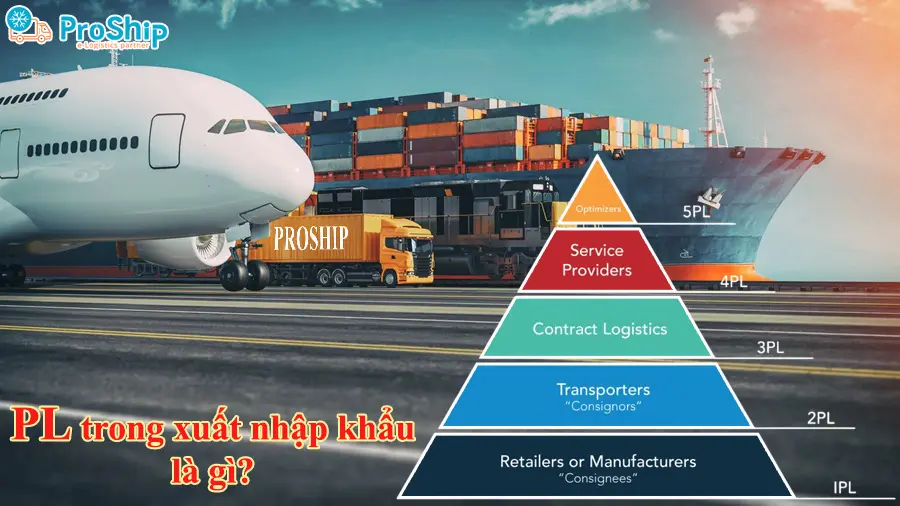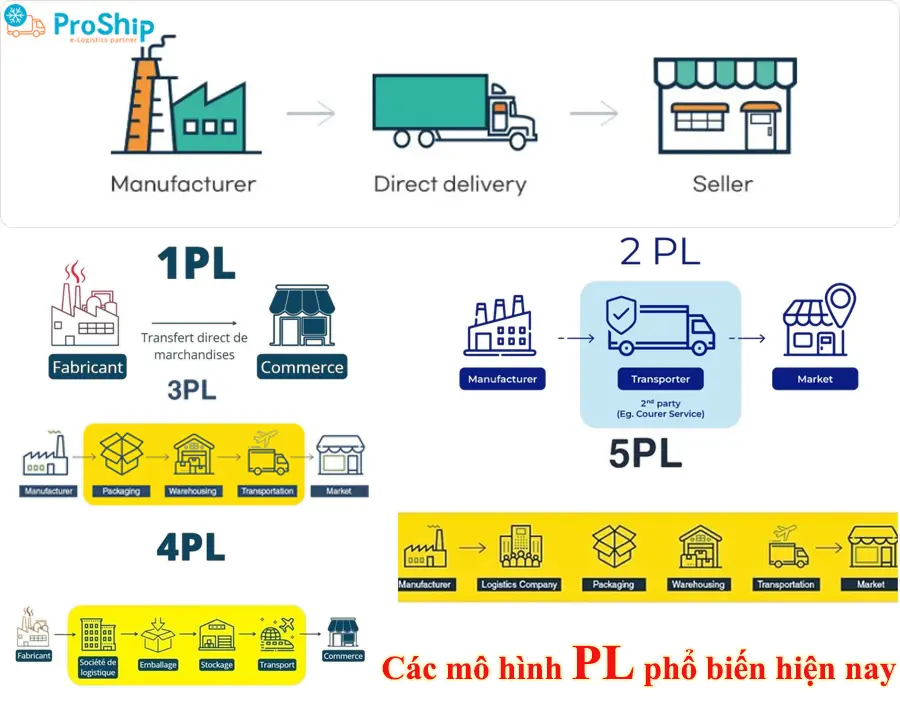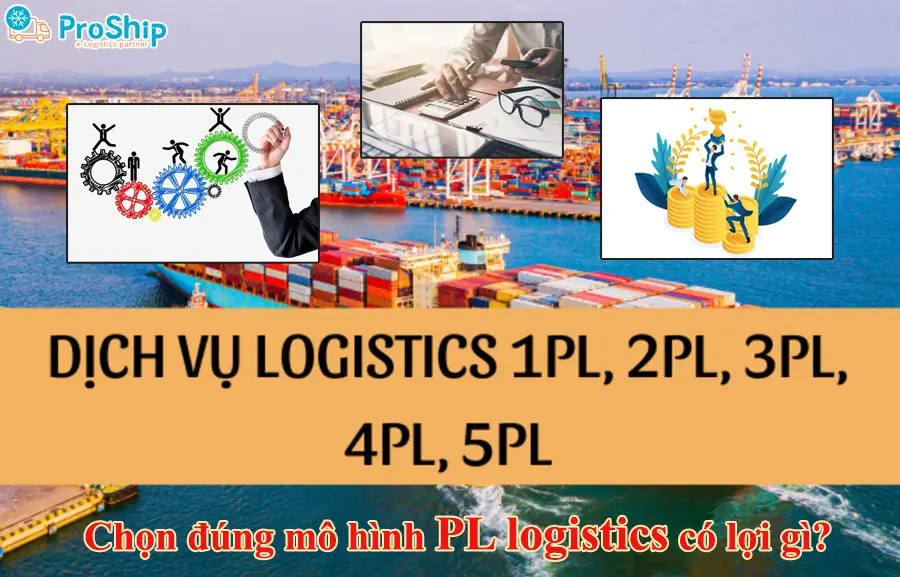X You have been and will be involved in the field of import and export to find out what the PL stands for, what does it mean?
X You want to know the PL in Logistics is decentralized into any common types and models today?
x Commercial businesses are interested in efficiency and benefits when choosing and applying the right PL model?
Let Proship.vn find out what PL is in import and export and PL logistics models popular from 1PL to 5PL and the role, advantages, benefits, how the operation of each type of PL in the supply chain is like. At the same time, businesses also know how to apply PL to ensure the highest efficiency.
What is PL in import and export?
What is PL in import and export? PL Logistics is an important term in the field of import and export and supply chain. PL stands for the phrase " Production and Logistics", representing logistics models to organize supply chain operation in logistics. Import -export enterprises often apply PL logistics to optimize the process of transportation, warehousing management, packaging and delivery of goods.
In addition to the above understanding, PL is also understood as Packing List (Packing list) - an important document to detail the information of exported goods such as name, volume, size and number of each item.

The popular popular PL models today
What are the common models of PL in import and export? Proship has synthesized and listed the Production and Logistics PL models popular for businesses, including:
1PL (First Party Logistics)
1PL (First Party Logistics), also known as self -sufficient logistics, enterprises carry out logistics activities by themselves without support from a third party. The advantage of the 1PL model is that the enterprise controls the quality and shipping cost.
But it also takes a lot of time, effort and operating management costs. In fact, there are very few big businesses choose the type of 1PL logistics. Businesses apply 1PL form such as:
- Small and medium units, small business networks, easy -to -consume goods, short shipping distance;
- The large corporation has a global logistics network with all the warehouse systems, personnel, transportation means, ...
2PL (Second Party Logistics)
2PL (Second Party Logistics) is a form of rental from 2nd party, also known as partial import and export. The business is only in charge of a certain activity in the supply of goods.
2PL Service Company owns a specialized means of transportation to serve a single step in the logistics chain such as transportation, warehouse, payment, customs procedures, ... on the market, there are many large transport companies that provide 2PL logistics services such as Maersk, Wanhai, Mol, Evergreen, NYK, ...
3PL (Third Party Logistics)
3PL (Third Party Logistics) is a form of import -export business, only logistics service providers for third parties. 3PL, also known as logistics under the contract. As the owner of an external service that performs all or a few small activities in the supply chain:
- Representatives of goods owners carry out customs procedures, import and delivery documents;
- Carry out warehousing, transportation, packaging and unloading;
- Goods are guaranteed transportation to the right place.
The advantage of 3PL is to take advantage of the third unit's expertise, help reduce risks and increase logistics efficiency. In particular, 3PL companies have a close relationship with 2PL to save time and cost for guests.

4PL (Fourth Party Logistics)
4PL (Fourth Party Logistics) is a logistics model according to the distribution chain. The 4PL units formed on the platform of 3PL but the model is larger. The company is responsible for managing and implementing complex logistics activities. Including resource management, facilities, coordination and control to optimize the best supply chain operation.
The 4PL logistics model is increasingly important in businesses. In particular, the company or representative organization will be authorized by customers as the management, implementation and efficient improvement of the whole hard supply process.
The highlight of 4PL is the application of information technology and business process management. Thereby helping import -export companies reduce costs and increase the competition of the supply chain. At the same time help build and operate the best import -import business solution.
5PL (Fifth Party Logistics)
5PL (FIFTH Party Logistics) perform all the operation of the operation of the 3PL and 4PL distribution chain on e -commerce platform. The characteristic feature of 5PL is the close linkage system between:
- Order management system (OMS);
- Warehouse management system (WMS);
- Transportation management system (TMS).
5PL model suitable for small and medium -sized businesses and businesses. This model makes it easy to integrate and professionally integrate the management system and increase the efficiency of import and export business.
Choose the right PL logistics model? How to apply PL?
After finding out what PL is in import and export, the PL classification, it is necessary to know the benefits when choosing the right PL model and how to apply PL is also essential for many businesses. Specifically:
Benefits when choosing the right PL logistics model
The correct application of PL logistics model helps businesses:
- Enhance operating efficiency: Logistics activities are automated and smarter management;
- Cost optimization: Thanks to outsourcing or integrating modern technology in supply chain management;
- Improve competitiveness: Thanks to the quick and effective logistics service, businesses can easily meet the market demand.

PL steps used in commercial enterprises
Enterprises use PL in commercial activities in the way:
- Consulting and introducing and advertising to customers the methods related to transportation that such business provides to consumers;
- Packing products and goods into boxes and packaging;
- Stamping with the symbol code of products and brands of the business on products and goods;
- Carry out the transportation of goods to archives;
- Managing storage problems for goods that do not need to transport;
- Particularly for large -sized goods or too much, it can be carried out for storage in larger warehouses;
- Carrying out a number of customs procedures and procedures related to import and export;
- To fully prepare all kinds of papers, records and documents necessary for the import and export process and provide services to customers;
- Conducting delivery, and providing customers with other services according to their requirements.
Thus, what is PL in import and export and PL models that have been developing strongly in commercial enterprises that have been shared by Proship Logistics. Based on this, online shops, businesses, business households, e -commerce floors, ... can refer and choose a suitable PL model, optimize costs and time. Contact immediately 0909 344 247 for advice and quotation of transport solutions, bonded warehouse rental, ... the most cost -saving.
